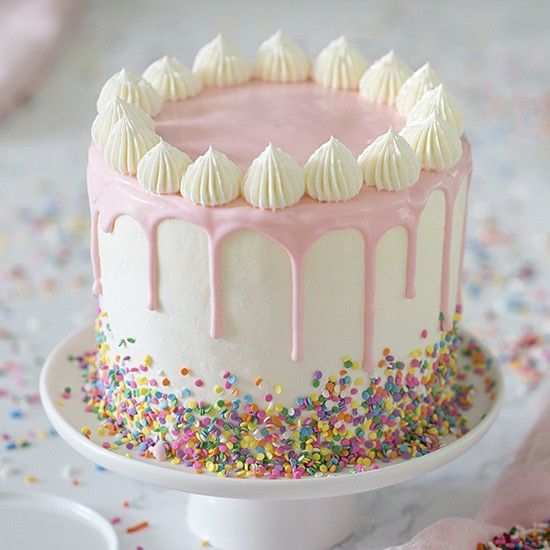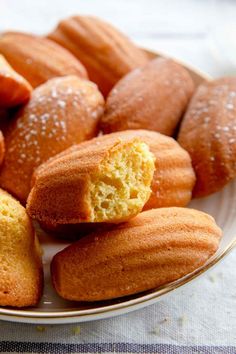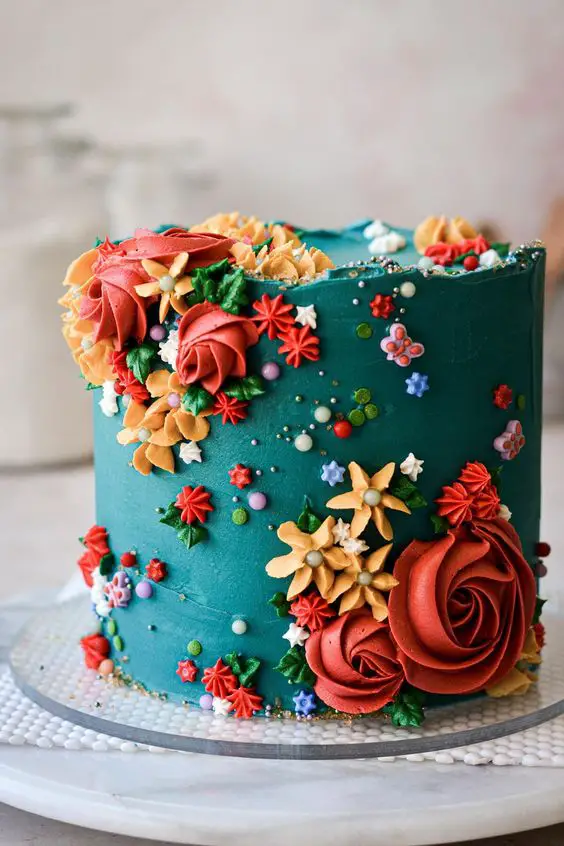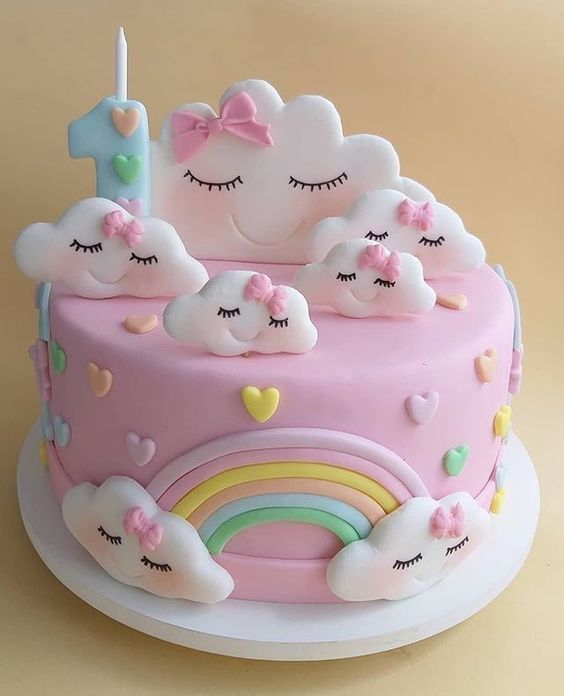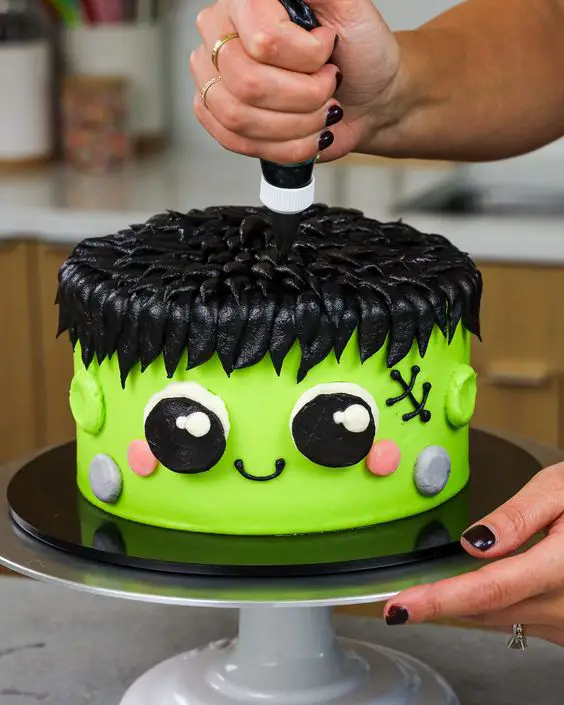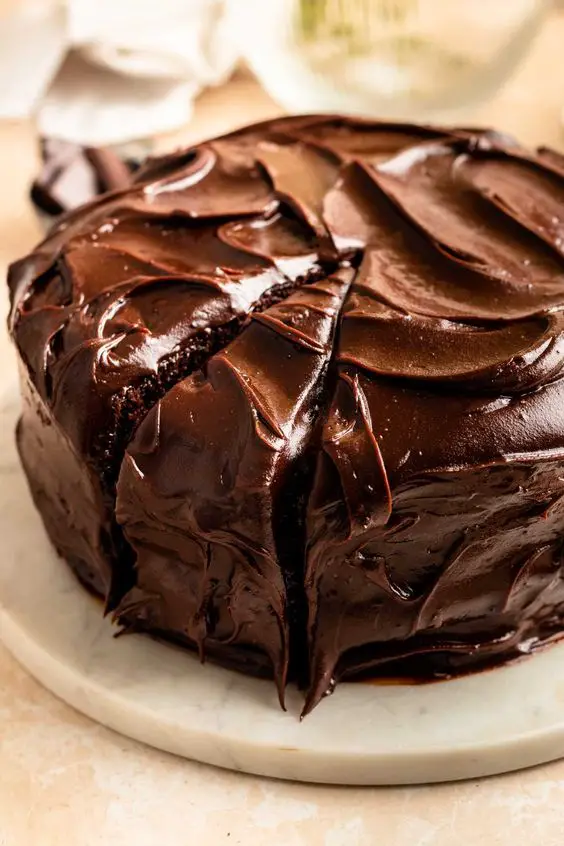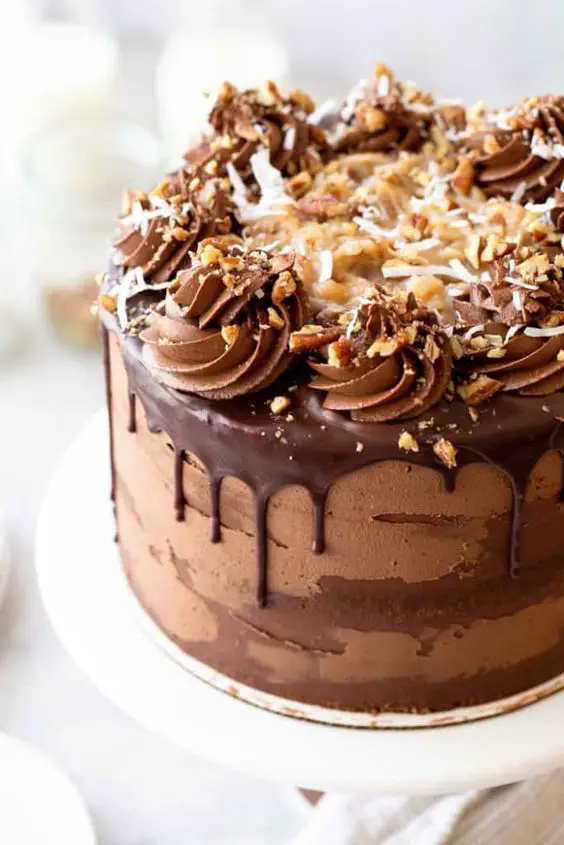Indulge in the timeless delight of a Vanilla Cake – a classic and beloved dessert that captures the essence of simplicity and elegance. With its light, fluffy texture and delicate vanilla flavor, this cake is a true crowd-pleaser that never goes out of style. Whether served as a standalone treat or adorned with luscious frosting and decorations, the Vanilla Cake’s versatility makes it perfect for any occasion – from casual gatherings to grand celebrations. So, prepare to savor the pure essence of vanilla as we delve into the world of this timeless and comforting confection, destined to bring joy to the hearts and palates of all who taste its delightful charm.

What is Vanilla Cake?
Vanilla Cake is a classic and beloved dessert that epitomizes simplicity, elegance, and delightful flavor. It is a tender and moist cake featuring a pronounced vanilla taste, making it a timeless favorite for all ages. This versatile cake serves as a blank canvas, perfect for a myriad of frostings, fillings, and decorations, allowing for endless creativity and personalization.
The key ingredients in a Vanilla Cake typically include cake flour, granulated sugar, eggs, unsalted butter or oil, milk or buttermilk, baking powder, salt, and pure vanilla extract (or sometimes vanilla bean seeds). The cake batter is carefully mixed and then baked to perfection, resulting in a light and fluffy crumb with a delectable vanilla essence.
Whether enjoyed as a simple treat or lavishly adorned for special occasions, Vanilla Cake holds a special place in the hearts of dessert enthusiasts worldwide. Its ability to evoke feelings of comfort and nostalgia makes it a cherished choice for birthdays, weddings, celebrations, and any moment that calls for a delightful and heartwarming dessert. With its pure and delightful taste, Vanilla Cake promises to bring joy and satisfaction to all who experience its timeless charm.

Is Vanilla Cake the same as White Cake?
While Vanilla Cake and White Cake are often used interchangeably, they are not precisely the same, though they share some similarities. Let’s break down the differences between the two:
Vanilla Cake:
- A Vanilla Cake refers to a cake that features a prominent vanilla flavor. It is made using a combination of ingredients, including cake flour, sugar, eggs, butter or oil, milk, baking powder, and vanilla extract (or sometimes vanilla beans). The key distinguishing factor is the presence of a noticeable vanilla taste.
White Cake:
- A White Cake, on the other hand, is a cake made with a specific goal of achieving a whiter crumb color. To achieve this, it primarily uses egg whites instead of whole eggs. The absence of egg yolks reduces the yellow tint, resulting in a whiter appearance.
The Overlap:
- The confusion arises because many Vanilla Cake recipes also produce a cake with a light-colored crumb, similar to White Cake. This is because most Vanilla Cake recipes use only a small amount of egg yolks, and the dominant vanilla flavor masks the subtle difference in color. In other words, a Vanilla Cake can often be quite “white” in appearance, which leads people to refer to it as White Cake.
Conclusion: In essence, while there may be overlap in color and flavor, the primary distinction between Vanilla Cake and White Cake lies in the intention behind each. Vanilla Cake emphasizes the use of vanilla extract or beans for flavor, while White Cake aims for a whiter crumb by utilizing egg whites. It’s important to note that different bakers and recipes may use the terms interchangeably or apply them differently based on regional or personal preferences. Regardless of the terminology, both cakes are delicious and versatile options for a range of occasions.

How to customize the frosting for Vanilla Cake?
Customizing the frosting for Vanilla Cake is a delightful way to add your personal touch and create a unique and delicious dessert. Here’s a step-by-step guide to help you customize the frosting to suit your taste:
1. Choose a Base Frosting: Start by selecting a base frosting that complements the Vanilla Cake’s flavor. Popular choices include Vanilla Buttercream, Chocolate Ganache, Cream Cheese Frosting, Whipped Cream Frosting, or any other frosting that pairs well with vanilla.
2. Flavor Enhancements: Experiment with various flavor enhancers to infuse the frosting with exciting tastes. Consider adding:
- Extracts: Add a few drops of different extracts like almond, lemon, orange, coconut, or mint to create unique flavor profiles.
- Citrus Zest: Grate the zest of lemons, limes, or oranges into the frosting for a fresh and zesty twist.
- Instant Coffee or Espresso: Dissolve a small amount of instant coffee or espresso in a bit of hot water and blend it into the frosting for a subtle coffee flavor.
3. Incorporate Nut Butters: For nutty and rich flavors, try mixing in some peanut butter, almond butter, or hazelnut spread into the frosting. These nut butters not only add flavor but also create a smooth and creamy texture.
4. Add Fruit Puree or Jam: Introduce a fruity element by folding in fruit puree or jam into the frosting. This can be done with strawberry, raspberry, blueberry, or any other fruit that complements vanilla.
5. Drizzles and Swirls: Consider adding drizzles or swirls of syrups like caramel, butterscotch, raspberry sauce, or chocolate sauce on top of the frosting. This not only enhances the flavor but also creates an attractive presentation.
6. Food Coloring: Use food coloring to tint the frosting and create a visually appealing cake. Pastel shades for a delicate look or bold colors for a more vibrant presentation can be great choices.
7. Texture Variations: Play with texture by adding chopped nuts, crushed cookies, or mini chocolate chips to the frosting. This adds interesting bites and crunch to the cake.
8. Taste Testing: After incorporating your desired customizations, taste the frosting to ensure it aligns with your preferences. Make any necessary adjustments to achieve the desired flavor and consistency.
9. Decorate Creatively: Use your customized frosting to decorate the Vanilla Cake creatively. You can pipe designs, create swirls, or spread it smoothly for a clean finish. Add additional toppings or garnishes to elevate the presentation.
Remember to keep track of the measurements and adjustments you make during the customization process, especially if you find a combination you love. By customizing the frosting, you’ll have a unique Vanilla Cake that reflects your taste and creativity, making it a truly special dessert for you and your loved ones to enjoy.

FAQ’s about Vanilla Cake:
- What is a Vanilla Cake? A Vanilla Cake is a classic and versatile dessert made primarily with vanilla-flavored batter. It’s a light and fluffy cake that serves as a perfect canvas for various frostings, fillings, and decorations.
- Is Vanilla Cake the same as White Cake? Vanilla Cake and White Cake are often used interchangeably, but they are not precisely the same. Vanilla Cake refers to a cake with a prominent vanilla flavor, while White Cake refers to a cake made with egg whites, resulting in a whiter crumb color.
- What makes the Vanilla Cake moist and tender? The moist and tender texture of a Vanilla Cake is achieved by using a balanced combination of ingredients like cake flour, sugar, eggs, butter or oil, milk, baking powder, and vanilla extract. The careful mixing and baking process also play a significant role in the cake’s texture.
- Can I use vanilla extract instead of vanilla bean in the recipe? Yes, you can substitute vanilla extract for vanilla bean in most Vanilla Cake recipes. However, keep in mind that the flavor intensity might be slightly different. Typically, 1 teaspoon of vanilla extract can replace the seeds scraped from one vanilla bean.
- Can I customize the frosting for Vanilla Cake? Absolutely! Vanilla Cake pairs well with a wide range of frostings and fillings, such as vanilla buttercream, chocolate ganache, cream cheese frosting, fruit compotes, or even a simple dusting of powdered sugar.
Troubleshooting:
- Why did my Vanilla Cake turn out dry and crumbly? A dry and crumbly cake can result from overbaking or using too much flour. Ensure you measure the ingredients accurately and follow the specified baking time in the recipe.
- How can I prevent my Vanilla Cake from sinking in the middle? Cake sinking can happen due to several reasons, such as overmixing the batter, opening the oven door too early, or using expired leavening agents like baking powder or baking soda. To avoid sinking, follow the recipe instructions carefully and check the freshness of your leavening agents.
- My cake didn’t rise properly. What went wrong? Insufficient leavening agents or incorrect oven temperature can cause a cake not to rise properly. Ensure your baking powder or baking soda is fresh and your oven is preheated to the correct temperature.
- Can I make a Vanilla Cake without eggs for an eggless version? Yes, you can make an eggless version of Vanilla Cake by using egg substitutes like applesauce, yogurt, mashed bananas, or commercial egg replacers. It’s essential to follow an eggless Vanilla Cake recipe to achieve the best results.
- My frosting turned out too runny. How can I fix it? If your frosting is too runny, you can thicken it by adding more powdered sugar or chilling it in the refrigerator for a short time. Alternatively, you can also add a little cornstarch or cream cheese to stabilize the frosting.
Remember, baking is an art that may require some trial and error. Don’t be discouraged by minor setbacks; instead, use these troubleshooting tips to improve your Vanilla Cake baking skills and enjoy the process of creating this timeless and delightful dessert.

Here’s a detailed formula for making a delicious Vanilla Cake with a classic vanilla buttercream frosting:
Vanilla Cake Recipe:
Ingredients:
For the Vanilla Cake:
- 2 and 1/2 cups cake flour
- 2 and 1/2 teaspoons baking powder
- 1/2 teaspoon baking soda
- 1/2 teaspoon salt
- 1 and 1/4 cups granulated sugar
- 1/2 cup unsalted butter, softened
- 3 large eggs, at room temperature
- 1 tablespoon pure vanilla extract
- 1 cup whole milk, at room temperature
For the Vanilla Buttercream Frosting:
- 1 and 1/2 cups unsalted butter, softened
- 4 cups powdered sugar (confectioners’ sugar)
- 2 teaspoons pure vanilla extract
- 2-3 tablespoons whole milk or heavy cream
Optional Enhancements:
- 1 teaspoon lemon zest or orange zest (for a citrus twist)
- 1/4 cup fruit puree or jam (strawberry, raspberry, etc.)
- 1/2 cup nut butter (peanut butter, almond butter, etc.)
- Food coloring (if desired)
- Garnishes (fresh fruit, chocolate chips, sprinkles, etc.)
Instructions:
For the Vanilla Cake:
- Preheat your oven to 350°F (175°C). Grease and flour two 9-inch round cake pans. Line the bottom with parchment paper for easy removal.
- In a medium bowl, whisk together the cake flour, baking powder, baking soda, and salt until well combined. Set aside.
- In a large mixing bowl, beat the softened butter and granulated sugar together with an electric mixer until light and fluffy.
- Add the eggs one at a time, beating well after each addition. Mix in the pure vanilla extract.
- Gradually add the dry flour mixture to the wet ingredients, alternating with the whole milk. Begin and end with the flour mixture. Mix until just combined, avoiding overmixing.
- Divide the cake batter equally between the prepared cake pans, smoothing the tops with a spatula.
- Bake the cakes in the preheated oven for approximately 25-30 minutes or until a toothpick inserted into the center comes out clean.
- Remove the cakes from the oven and let them cool in the pans for about 10 minutes. Then, transfer them to wire racks to cool completely.
For the Vanilla Buttercream Frosting:
- In a large mixing bowl, beat the softened butter with an electric mixer until creamy and smooth.
- Gradually add the powdered sugar, mixing on low speed after each addition. Once all the sugar is incorporated, increase the speed to medium and continue to beat until light and fluffy.
- Add the pure vanilla extract and continue to mix until well combined.
- Depending on the desired consistency, add 2-3 tablespoons of whole milk or heavy cream to the frosting, one tablespoon at a time, and beat until the frosting is smooth and spreadable.
Customizations:
- For a citrus twist: Add 1 teaspoon of lemon zest or orange zest to the cake batter or frosting.
- For a fruity touch: Fold 1/4 cup of fruit puree or jam into the frosting.
- For a nutty flavor: Incorporate 1/2 cup of nut butter (peanut butter, almond butter, etc.) into the frosting.
- For colored frosting: Add a few drops of food coloring to achieve the desired hue.
Assembling the Vanilla Cake:
- Once the cakes are completely cooled, level the tops if necessary to create an even surface.
- Place one cake layer on a serving plate or cake stand.
- Spread a generous amount of the vanilla buttercream frosting on top of the first layer.
- If desired, add any optional enhancements, such as fruit puree, jam, or nut butter on top of the frosting.
- Carefully place the second cake layer on top.
- Frost the entire cake with the remaining vanilla buttercream, creating a smooth and even layer on top and around the sides.
- Optionally, decorate the cake with garnishes like fresh fruit, chocolate chips, or sprinkles for an appealing finish.
Serve and Enjoy:
Slice and serve the Vanilla Cake at room temperature. This delightful and customizable treat is perfect for any occasion, and with your personalized touches, it becomes a unique and cherished dessert that everyone will love!
Please note that the nutrition information provided below is an approximate estimate and can vary based on the specific ingredients and quantities used in the recipe. Additionally, the serving size may differ depending on how the cake is sliced. The values mentioned here are based on a standard serving size of 1 slice (1/12th of the cake).
Nutrition Information for Vanilla Cake (Per Serving):
- Calories: ~350-400 kcal
- Total Fat: ~15-20g
- Saturated Fat: ~9-12g
- Cholesterol: ~60-80mg
- Sodium: ~200-300mg
- Total Carbohydrates: ~50-60g
- Dietary Fiber: ~0-1g
- Sugars: ~35-45g
- Protein: ~3-5g
Please note that the nutrition content can vary depending on the specific ingredients and quantities used in the recipe. For instance, using butter versus oil, whole milk versus skim milk, or adding additional ingredients can alter the overall nutritional profile.
Since Vanilla Cake is a treat and typically enjoyed in moderation, it’s essential to be mindful of portion sizes and consume it as part of a balanced diet. If you have specific dietary requirements or health concerns, it’s always a good idea to consult with a registered dietitian or nutritionist for personalized guidance.

Why you will love Vanilla Cake?
There are several reasons why you will love Vanilla Cake:
1. Classic and Timeless: Vanilla Cake is a classic dessert that has stood the test of time. Its simplicity and delicate flavor have made it a beloved choice for generations.
2. Versatile Canvas: It serves as a blank canvas for creativity, allowing you to customize the frosting, fillings, and decorations to suit your preferences and occasions.
3. Pure and Delicate Flavor: The gentle essence of pure vanilla infuses the cake, creating a subtly sweet and comforting taste that appeals to a wide range of palates.
4. Crowd-Pleaser: Vanilla Cake is a crowd-pleaser, loved by both adults and children. It’s a safe choice for gatherings and celebrations where everyone can enjoy a delightful slice.
5. Celebrate Any Occasion: Whether it’s a birthday, anniversary, or any special moment, Vanilla Cake is a versatile dessert that complements any occasion.
6. Nostalgic Charm: Biting into a slice of Vanilla Cake can evoke feelings of nostalgia, reminding you of cherished moments and childhood treats.
7. Easy to Pair and Enhance: It pairs exceptionally well with various fillings, frostings, and toppings, offering endless possibilities for flavor combinations.
8. Light and Fluffy Texture: The soft and airy crumb of Vanilla Cake provides a delightful eating experience, making it a delightful treat to savor.
9. Perfect for All Seasons: Whether it’s served warm with a scoop of ice cream in the winter or accompanied by fresh fruits in the summer, Vanilla Cake suits every season.
10. Comfort Food: It brings comfort and joy during challenging times, making it a go-to dessert for moments that need a sweet pick-me-up.
11. Baking Pleasure: Baking a Vanilla Cake is a rewarding experience, and it allows you to enjoy the process of creating a delicious masterpiece from scratch.
12. Endless Customization: With various optional enhancements and personal touches, you can tailor the cake to your liking, making it uniquely yours.
In summary, Vanilla Cake’s charm lies in its simplicity, versatility, and ability to evoke warm feelings of comfort and joy. It’s a dessert that transcends generations, and whether served at a grand celebration or enjoyed as a delightful treat, Vanilla Cake promises to leave you with a smile and a satisfied palate after every delectable bite.
How to serve Vanilla Cake
Serving Vanilla Cake is a delightful experience, and there are several ways to present and enjoy this classic dessert. Here’s a guide on how to serve Vanilla Cake to make it even more special:
1. Cake Presentation:
- Place the Vanilla Cake on a beautiful cake stand or serving platter to create an elegant centerpiece. Choose a stand that complements the cake’s simplicity and charm.
2. Slicing the Cake:
- Use a sharp, serrated knife to slice the cake into individual servings. Wipe the knife with a clean, damp cloth between cuts to ensure clean slices.
3. Frosting and Decoration:
- If your Vanilla Cake has a frosting, make sure it is evenly spread on top and around the sides of the cake. You can smooth it with a spatula or create decorative swirls for an attractive presentation.
- Optionally, add extra garnishes like fresh berries, edible flowers, or a dusting of powdered sugar to enhance the cake’s visual appeal.
4. Serve at Room Temperature:
- Allow the Vanilla Cake to come to room temperature before serving. This brings out the full flavor and enhances the cake’s texture.
5. Accompaniments:
- Vanilla Cake is delicious on its own, but you can elevate the experience by serving it with complementary accompaniments, such as:
- A dollop of freshly whipped cream on the side.
- A scoop of ice cream, especially flavors like vanilla, strawberry, or chocolate.
- A drizzle of chocolate or caramel sauce for an extra touch of decadence.
6. Tea or Coffee:
- Serve the Vanilla Cake with a hot cup of tea or coffee for a delightful afternoon treat.
7. Individual Plating:
- For a more formal occasion or dinner party, consider pre-slicing the cake and serving each slice on individual dessert plates.
8. Celebratory Touch:
- Add a sparkler or a candle on top of the cake if it’s for a celebration like a birthday. It adds a festive touch and creates a memorable moment.
9. Sharing the Joy:
- Vanilla Cake is a dessert that brings people together. Share it with friends and family to create cherished moments and memories.
10. Leftovers:
- If you have leftovers, store the cake in an airtight container at room temperature for a day or two, or in the refrigerator for longer-term storage. Bring it back to room temperature before serving again.
Remember, serving Vanilla Cake is all about creating a delightful experience that celebrates its classic flavor and simple charm. Whether you’re hosting a special occasion or enjoying a quiet moment with loved ones, savoring a slice of Vanilla Cake is sure to bring joy and happiness to all who partake in this timeless dessert.
How to store Vanilla Cake
Properly storing Vanilla Cake is crucial to maintain its freshness and deliciousness. Here are some guidelines on how to store the cake to keep it at its best:
1. Room Temperature:
- If the Vanilla Cake has a buttercream or non-perishable frosting (like chocolate ganache), it is safe to store the cake at room temperature in a cool, dry place, away from direct sunlight or heat sources.
- Keep the cake covered with a cake dome, an overturned large bowl, or loosely tented with plastic wrap or aluminum foil to prevent it from drying out.
2. Refrigeration:
- If the Vanilla Cake has a frosting that contains perishable ingredients like cream cheese or whipped cream, it is best to store the cake in the refrigerator.
- Place the cake in an airtight container or cover it tightly with plastic wrap or aluminum foil to protect it from absorbing odors or drying out.
- Before serving, let the refrigerated cake come to room temperature for about 30 minutes to an hour. This will enhance its flavor and restore its soft texture.
3. Freezing:
- Vanilla Cake can be frozen for longer-term storage. To freeze the cake, make sure it has cooled completely.
- Wrap the cake tightly with plastic wrap or place it in an airtight container. For added protection, you can wrap the cake again with aluminum foil.
- Frozen cakes can typically be stored for up to 2-3 months in the freezer.
- To thaw the cake, remove it from the freezer and let it defrost in the refrigerator overnight. Alternatively, you can thaw individual cake slices at room temperature for a few hours.
4. Protect from Odors:
- Whether storing at room temperature, in the refrigerator, or freezer, ensure that the Vanilla Cake is kept away from strong-smelling foods or substances. Vanilla Cake can absorb odors, which might affect its flavor.
5. Avoid Moisture:
- Keep the cake away from excessive moisture or humidity, as this can lead to a soggy texture and spoilage.
6. Separate Tiers:
- If your Vanilla Cake has multiple tiers, it’s best to store them separately to prevent them from sticking together or losing their shape.
By following these storage guidelines, you can preserve the freshness and quality of your Vanilla Cake, ensuring that it remains a delectable treat to be enjoyed even after a day or two. Remember to consider the type of frosting used, as this will determine the ideal storage method for your specific cake.
Happy baking!

